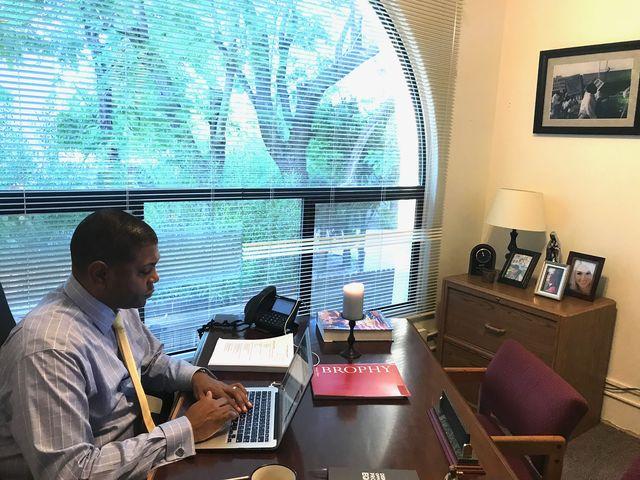Photo by Jackson Moran ’21 | Dr. Matthew Whitaker works in the newly created Office of Equity and Inclusion.
By Jackson Moran ’21
THE ROUNDUP
The Office of Equity and Inclusion (OEI) is a new addition to the administration on campus this year, located in Romley Hall, and is lead by Dr. Matthew Whitaker.
According to their vision statement, the OEI’s purpose is “to promote and teach the value of an equitable and inclusive community and provide the necessary tools to be culturally competent in our increasingly diverse society.”
Mr. Bob Ryan said that his main motivation in creating an OEI was the desire for our school and its programs to “reflect the student body and the parent population of the students who are here now versus the students who were here thirty years ago.” With the ever-changing demographics of our community and country, Brophy tries to stay current with our social environments.
Mr. Ryan’s goal as principal, and the goal of the OEI, is to see our community “reflect the world that we live in” and adequately prepare us for the world that we enter upon graduation.
He cited that our diversity as a school accurately mirrors that of Maricopa county.
“The OEI has been in the works for many years,” said Mr. Ryan.
Many faculty members had contributed towards its implementation and current workings including Mr. Jonathan Londoño ’10, Mr. Will Rutt ’08, Mr. Austin Pidgeon ’08 and Mrs. Tanea Hibler.
Faculty diversity is also a concern for the OEI, especially during the hiring process.
Mr. Ryan said that the hiring process is incredibly important to him, and that he looks for capability above all else.
However, Mr. Ryan also stated that an applicant who “brings something else to the table,” such as a diverse background, as well as proper credentials would be likely to get the job over another applicant.
The task of hiring also reaches Dr. Whitaker’s desk, as he is called upon for connections to diverse people who could fill different personnel positions.
The OEI also hopes to get intimately involved with student affairs, especially student culture clubs, by implementing on- and off-campus initiatives.
There are currently nine cultural clubs registered at Brophy, including the Black Student Union (BSU), Hermanos Unidos, the Jewish Student Union, Brophy Advocacy Club, and Brophy Culture Project.
These clubs provide students with an opportunity to build community by surrounding themselves with students of similar backgrounds and heritage, as well as students who wish to learn and discover other cultures.
The OEI hopes to get more students involved in these clubs and unions, no matter their own background.
A common theme amongst the clubs is that they often do not accurately represent the total populations of their respective groups on campus.
“I think we are still a small number, because there’s still a lot of people who don’t know about the club, so we would like more people to come and learn about it and contribute to the club,” said Gustavo Sanchez-Garcia ’19, president of Hermanos Unidos.
Greyson Taylor ’19, member of the leadership committee for the BSU, has seen Brophy change a lot since his Freshman year.
“As the years progressed, I saw much more people of different races and cultures coming into Brophy,” said Taylor.
Taylor said that equal opportunities are very important to him and that he was glad to see that now “everyone has a spot at the table and the same plate of food.”
Outreach in the community outside of Brophy’s campus is just as important, as displayed by Dr. Whitaker’s commitment to parents and future applicants.
The OEI has many ideas for initiatives, some led by students, to promote equality in our community.
One that was mentioned was “Translators for Others” which Dr. Whitaker explained as a program in which “multilingual students attend events in order to communicate with parents and other community members.”
A second initiative he mentioned was “Woke Masculinity. “This would be a series of programs where experts would be brought to campus to, “Engage the student population and various faculty and staff on various topics,” said Dr. Whitaker.
Some of these topics include toxic masculinity, operationalizing faith to combat inequality, and becoming allies to the disenfranchised.
Many things have already been done to promote equity and inclusion at Brophy, most notably in 2011 with the creation of the Loyola Academy.
The Academy is a 6th-8th grade school where financially disenfranchised students of many different backgrounds receive a free Jesuit education.
This was “a great step in the right direction,” said Dr. Whitaker.
The OEI hopes to continue outreach to middle schoolers by partnering with the Admissions Office to implement “Operation Inclusion,” to recruit students, showing them that Brophy is an option for them, no matter their financial status or cultural/religious background.
Parent outreach is just as important to the OEI, as Padres Latinos Unidos de Brophy and the Black Family Alliance have been created in the past few years.
This gives parents of students from different backgrounds a support network and commonality.
It also helps the OEI and the Admissions Office with Operation Inclusion, by showing parents that Brophy is a viable opportunity for their sons.
Dr. Whitaker and Mr. Ryan both ended with was that they hope for the students at Brophy to get actively involved with the inclusion of others. This is part of the Jesuit Identity of “Men for Others” at Brophy and also an important part of the formation of brotherhood.
Students looking for more information about the OEI can follow them on Twitter and Instagram @BrophyOEI, find their page under “We Are Brophy” on the school website and get involved with any number of student culture clubs.



















